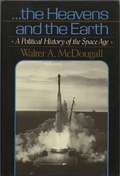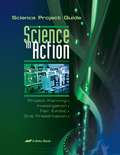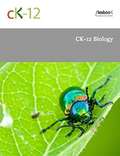- Table View
- List View
Handbook of Functional Neuroimaging of Cognition
by Roberto Cabeza Alan KingstoneThe theoretical and methodological developments in the use of functional neuroimaging techniques to study the neural basis of cognition, from early scientific efforts to link brain and behavior to the latest applications of fMRI and PET methods.
Science 10th Standard - Tamilnadu Board
by State Council of Educational Research TrainingScience Textbook for the 10th Standard Students preparing for Tamil Nadu State Board Exam.
Ariviyal (Science) 10th Standard - Tamilnadu Board
by State Council of Educational Research TrainingAriviyal (Science) Textbook for the 10th Standard Students, preparing for Tamil Nadu State Board Exam.
Metals and How to Weld Them (second edition)
by T. B. JeffersonIn addition to the information a student would need in order to learn to be an arc welder, this book has an appendix with metallurgy terms. That and its detailed index make this a useful reference tool for those working in careers where welding is an essential skill. There are many different metals, and there is a science of welding. Not just any metals can be bonded together. Each metal has its own properties and uses. There is also a chapter on precious metals.
Health and Wellness (7th Edition)
by Kelli Mccormack Brown Eric Golanty Gordon EdlinA text for an introductory class about health. Textbook has not been proofread.
Six Easy Pieces: Essentials of Physics Explained By its Most Brilliant Teacher
by Matthew Sands Robert B. Leighton Richard FeynmanEssentials Of Physics told by its Most Brilliant Richard P. Feynmen Richard P. Feynman (1918-1988) was widely recognized as the most creative physicist of the post-World War II period. His career was extraordinarily expansive. From his contributions to the development of the atomic bomb at Los Alamos during World War II to his work in quantum electrodynamics, for which he was awarded the Nobel Prize in 1965, Feynman was celebrated for his brilliant and irreverent approach to physics. It was Feynman's outrageous and scintillating method of teaching that earned him legendary status among students and professors of physics. From 1961 to 1963, Feynman, at the California Institute of Technology, delivered a series of lectures that revolutionized the teaching of physics around the world. SIX EASY PIECES, taken from these famous Lectures on Physics, represents the most accessible material from this series. In these six chapters, Feynman introduces the general reader to the following topics: atoms, basic physics, the relationship of physics to other topics, energy, gravitation, and quantum force. With his dazzling and inimitable wit, Feynman presents each discussion without equations or technical jargon. Readers will remember how�using ice water and rubber�Feynman demonstrated with stunning simplicity to a nationally televised audience the physics of the 1986 Challenger disaster. It is precisely this ability �the clear and direct illustration of complex theories�that made Richard Feynman one of the most distinguished educators in the world. Filled with wonderful examples and clever illustrations, SlX EASY PIECES is the ideal introduction to the fundamentals of physics by one of the most admired and accessible scientists of our time.
Mercury and the Sun (Planet Guides)
by Duncan BrewerHave you ever wondered where Mercury gots its name? What causes Solar Flares? Or Solar Winds? Or what are Sun Spots exactly? Learn the answers to these and other interesting questions in this simple read introductory book to Mercury and the Sun. You will learn about Mercury's composition, the different layers of the Sun and much more. Worth a look for any star gazers.
The Outer Edge: Classic Investigations of the Paranormal
by Tom Genoni Barry Karr Joe NiekellInvestigations into celestial portents, extraterrestrials, fortune telling, and visions of death.
The Planet Earth and The Universe (Planet Guides)
by Duncan BrewerThis short yet informative book discusses the Big Bang Theory, and how the planets were formed, as well as the debates of ancient astronomers whether the earth was the center of the Universe or if the sun was. Informative facts about the Earth as a planet, and interesting facts about its moon. Worth reading if interested in fundamental astronomy or the planets. Great for all ages. Scientific terms are defined in the text and in a glossary. Picture captions give meat to the story.
Jupiter (Planet Guides)
by Duncan BrewerThis short but informative book gives many fascinating facts about the Planet Jupiter. The book outlines the planet's history and scientific discovers about it through the ages. It talks about the planets place in mythology, as well as what NASA has discovered about its composition. Contains a glossary of terms, recommended books to read, and some very fascinating facts about its many moons. Worth reading for anyone interested in the planet Jupiter.
The Heavens and the Earth: A Political History of the Space Age
by Walter A. McdougallThis highly acclaimed study approaches the space race as a problem in comparative public policy. Drawing on published literature, archival sources in both the United States and Europe, interviews with many of the key participants, and important declassified material, such as the National Security Council's first policy paper on space, McDougall examines U.S., European, and Soviet space programs and their politics. Opening with a short account of Nikolai Kibalchich, a late nineteenth-century Russian rocketry theoretician, McDougall argues that the Soviet Union made its way into space first because it was the world's first "technocracy"―which he defines as "the institutionalization of technological change for state purpose." He also explores the growth of a political economy of technology in both the Soviet Union and the United States.<P><P> Pulitzer Prize Winner
Snakes (Nature's Children)
by Tim HarrisWhere do snakes live? What do snakes eat? How big are snakes? Are all snakes dangerous? Find out the answers to these questions and learn all about the physical characteristics, behavior, and habitats of snakes.
Charles Darwin: Evolution and Natural Selection
by Charles Darwin Bert James Loewenberg"On the twenty-fourth of November, 1859, the London publishing house of John Murray issued a small green-backed volume. The volume was entitled On the Origin of Species by Means of Natural Selection, or the Preservation of Favoured Races in the Struggle for Life.1 Charles Robert Darwin, the author, was a scientist who had written on geological and zoological topics with monographic competence. He had also written an interesting travel account which had reached a much wider public. As a naturalist on H. M. S. Beagle, an admiralty vessel engaged in a routine survey, he had reported findings in many areas of natural history and had also recorded his experiences in foreign lands." -opening paragraph
Saturn (Planet Guides)
by Duncan BrewerThis small book, al be it, small, is chock full of fascinating facts about the sixth planet from the Sun Saturn. It talks about its physical make up, its history and discoveries made about it over the years, as well as some interesting facts about its mythology. Worth a look if you are at all interested in astronomy.
The Outer Planets: Uranus, Neptune and Pluto (Planet Guides)
by Duncan BrewerThis valuable beginners guide to the outer planets will offer lots of fascinating facts about the three farthest planets, Uranus, Neptune and Pluto. It talks about their satelites, moons, rings, and formation, age, mass, and other important facts. The book also offers a glimpse into the past and how the different planets were discovered by ancient and more recent astronomers. Also offers a glossary of terms and a bibliography of further reading.
Science: Matter and Energy
by Jeremy Foster Gregory Parker Delores Shimmin Dewitt SteelePrepare your child for chemistry and physics through the foundational principles taught in Science: Matter and Energy. Start out with scientific measurements and the different forms of matter and graduate into the foundations of chemical reactions and properties of magnets and electricity. With proofs for Creation, section and chapter reviews, and over 500 pictures, charts, and graphs, your child will be able to smoothly transition into chemistry from his study of Science: Matter and Energy.
Science: Matter and Energy Laboratory Manual
by Jeremy Foster Brian Mcdivitt Dewitt Steele Gregory Parker Verne Biddle Tom Stone Barbara PorcherReinforce concepts taught in class with the 36 demonstrations in this Laboratory Manual. These labs are designed for the teacher to perform the demonstration with assistance from the child. Study volume, density, buoyancy, levers, magnetization, electric circuits and more with the hands on activities specifically detailed in these demonstrations. Each lab comes complete with a stated purpose, introduction, equipment list, instructions, and lab sheet for reporting results. Bring chemistry and physics concepts to life with this Laboratory Manual.
Science: Matter and Energy Quizzes
by Jeremy Foster Christine Hotke James RidgleyAs a parent, you know that you must inspect what you expect. Inspection provides key motivation to your teen to work hard and provides you with valuable assessment of his strengths and weaknesses as you guide his progress. Let A Beka help you make that inspection easy with these ready-made quizzes. The quiz book correlates with the text Science: Matter and Energy (2012), Science: Matter and Energy Tests, and Science: Matter and Energy Teacher Edition, which includes the curriculum/lesson plans. Answers and grading guidance are sold separately in Science: Matter and Energy Quiz Key. Grade 9. <p><p> Product Features<p> · The 39 quizzes provide weekly reinforcement of concepts.<br> · Each quiz contains 10 objective questions, taking a minimum of class time to take and to grade.<br> · A variety of formats such as multiple choice, modified true/false, matching, completion, and math problems prepares your teen for the tests and verifies that he understands a concept, no matter how it is presented.<br> · Each quiz includes the page numbers it covers in the text, making the quizzes adaptable to your schedule and your teen’s learning progress.
Science: Matter and Energy Tests
by Jeremy Foster Christine Hotke James RidgleySafety principles, repair basics, innovation tools—all depend on a proper understanding of God’s principles of design and His laws governing the universe. From Bernoulli’s principle to the second law of thermodynamics, you can know that your teen is understanding how some things work while other things can’t through these well-designed tests that reinforce and evaluate his learning. The test book is correlated with the texts Science: Matter and Energy (2012), Science: Matter and Energy Laboratory Manual, Science: Matter and Energy Quizzes, and Science: Matter and Energy Teacher Edition, which includes the curriculum/lesson plans. Answers and grading guidance are sold separately in Science: Matter and Energy Test Key. Grade 9.<p><p> Product Features<p> · Objective questions in a variety of formats test on multiple levels from recall and understanding to application.<br> · Since mathematics is the language of science, many tests include an application section of math problems corresponding to the problems demonstrated and practiced in the text. Your teen will see the necessity of both math skills and scientific knowledge as they are applied to practical life situations.<br> · Essay questions take your teen’s thinking skills to a higher level as he must explain the hows and whys of science. They also open his eyes to note God’s design in the physical world and to consider how things of man’s design work. Noting others’ creativity may lead to his own!<br> · Testing every three weeks (for a total of 12 tests) provides vital reinforcement of learning and an opportunity for your evaluation of your teen’s comprehension.<br> · Two nine-weeks exams and semester and final exams further reinforce concepts. Exposure to the concepts through reading, discussion, demonstration and practice, independent work, quizzes, tests, and then review examinations cements course content.<br> · Since every test clearly indicates the sections of the text it covers, you can adjust test taking to your teen’s progress through the text.<br> · As with all A Beka tests, the content and design reflect our half century of educational experience. directions are easy to understand and the layout is appealing. Test content is clearly covered in the course materials and is appropriate for the grade level.
Science in Action: Science Project Guide (6th Edition)
by Corinne Sawtelle Colette Stancel James Ridgley Rick EndersWhile scientific investigations and projects are very important parts of science education, they don’t need to be scary. This project guide is a great help. Its step-by-step instructions walk your teen through planning, experimenting, reporting, and presenting the findings of a complete science project—with samples included. Also included in the project guide are helpful worksheets for selecting a topic and problem, getting started, and evaluating the investigation plan. The 7 grading forms are actually checklists that make your evaluation easy and thorough. Be prepared for a great learning experience! Gr. 7–11.
CK-12 Biology I (with image descriptions)
by Ck-12 FoundationOpen source biology textbook from CK-12.



